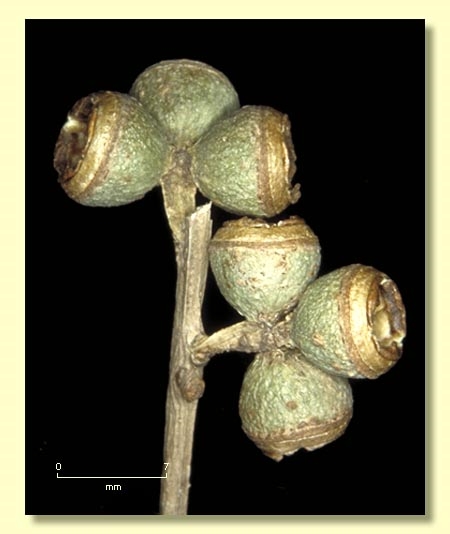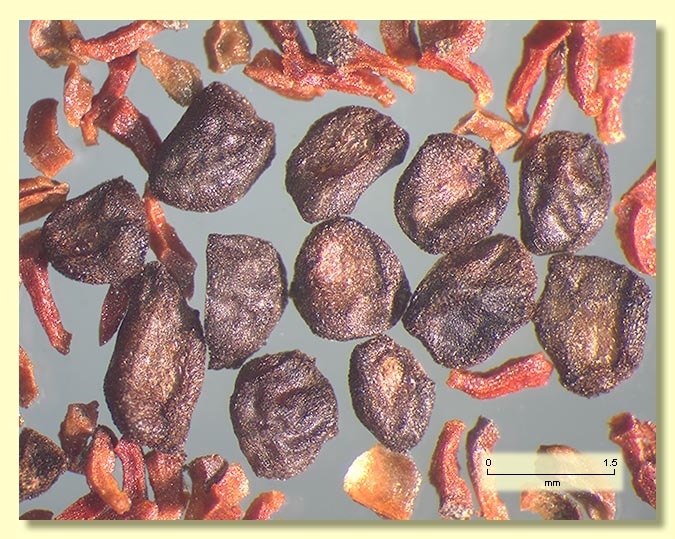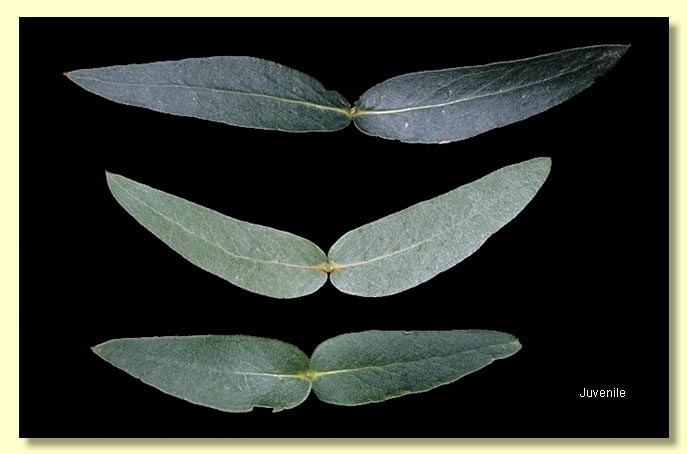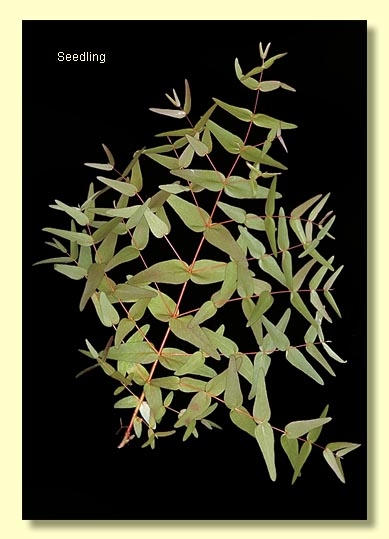Euclid - Online edition
Eucalyptus viminalis subsp. pryoriana
Eucalyptus | Symphyomyrtus | Maidenaria | Euryotae | Viminales | Lanceolatae
Eucalyptus pryoriana L.A.S.Johnson, Contr. New South Wales Natl Herb. 3: 115 (1962); E. viminalis var. racemosa F.Muell. ex Blakely, Key Eucalypts 162 (1934).T: Port Phillip, Vic., Feb 1880, ?F.Mueller s.n.; lectotype: NSW, fide L.A.S.Johnson, loc.cit.
Bark rough over most of trunk, stringy or fibrous, black to dark-grey or brown; smooth bark white to cream or pink-grey, crown sometimes ribbony.
Juvenile growth (coppice or field seedlings to 50 cm): stem rounded or square in cross-section; juvenile leaves opposite and sessile for many pairs, lanceolate to falcate, 3–8.5 cm long, 0.8–2 cm wide, base amplexicaul to rounded, green.
Adult leaves alternate, petiole 0.6–1.5 cm long; blade lanceolate to falcate, 7–21.5 cm long, 0.8–2.5 cm wide, base tapering to petiole, concolorous, glossy or dull, green, side-veins greater than 45° to midrib, moderately to densely reticulate, intramarginal vein parallel to and fairly close to margin, oil glands mostly island.
Inflorescence axillary unbranched, peduncles 0.4–1 cm long, buds 3 per umbel, on pedicels to 0.3 cm long, rarely sessile. Mature buds ovoid, 0.5–0.9 cm long, 0.4–0.5 cm wide, green to yellow, scar present, operculum conical to beaked, stamens inflexed or irregularly flexed, anthers cuboid to oblong, versatile, dorsifixed, dehiscing by longitudinal slits (non-confluent), style long, stigma blunt or tapered, locules 3 or 4, the placentae each with 4 vertical ovule rows. Flowers white.
Fruit sessile or on pedicels to 0.2 cm long, cup-shaped to hemispherical, 0.3–0.6 cm long, 0.5–0.8 cm wide, disc raised-convex to concave or annular, valves 3 or 4, strongly exserted or near rim level.
Seeds black, brown or grey, 1.5–3 mm long, ovoid or flattened-ovoid, often pointed at one end, lacunose, dorsal surface usually shallowly pitted, hilum ventral.
Cultivated seedlings (measured at ca node 10): cotyledons bilobed; stems rounded to square in cross-section, warty or smooth; leaves sessile, opposite for many nodes, lanceolate to falcate, 2–9.5 cm long, 0.3–2.5 cm wide, amplexicaul or base rounded to tapering, margin entire, apex pointed or rounded, discolorous, glossy, green above, paler beneath.
Flowering has been recorded in January, February, March, April and November.
Eucalyptus viminalis is a species of small to very tall tree, widespread in well-watered parts of south-eastern Australia from southern Eyre Peninsula and Kangaroo Island of South Australia through Victoria, Tasmania and eastern New South Wales as far north as the tablelands between Inverell and Deepwater extending east to the escarpment. It is recognised most easily by the many pairs of opposite, sessile, lanceolate, green juvenile leaves. The crown is usually ribbony and the bark is mostly smooth in mountain forms although many populations elsewhere have a black butt or rough bark over most of the trunk. It is related to E. rubida and E. dalrympleana, both of which have rounded, not narrowly lanceolate juvenile leaves. Another seven-budded form, occurring on the Northern Tablelands of New South Wales and its eastern escarpment, has been described recently as E. nobilis (q.v.).
There are four subspecies:
E. viminalis subsp. viminalis
Occurs mostly in wetter or seasonally well-watered areas in New South Wales, Victoria, Tasmania, Bass Strait islands and South Australia, particularly in mountain valleys but also on alluvium along streams on tablelands areas. Subsp. viminalis can be very tall (to 90 m in Tasmania) and is generally smooth-barked and three-budded. In South Australia it occurs only in the central part of the Mt Lofty Ranges.
E. viminalis subsp. cygnetensis
Has rough bark usually to the larger limbs and "umbels of seven buds, infrequently less, to as few as three" (Boomsma, 1980, p. 295). Subsp. cygnetensis occurs from the Grampians in Victoria, south-west to Mt Gambier in South Australia, on Kangaroo Island, in the Port Lincoln area, and in the Mt Lofty Ranges where the rough-barked plants occur with mixtures of umbels in threes and sevens. Plants with 3s and 7s also occur in the Grampians.
E. viminalis subsp. hentyensis
Endemic to Tasmania where it grows on poor white sands on the west coast, north from Strahan. Subsp. hentyensis has little rough bark, coarse, broad juvenile leaves and buds in threes or sevens.
E. viminalis subsp. pryoriana
Subsp. pryoriana is endemic to Victoria and is a small tree of infertile coastal sands from south of Geelong to east of Marlo in Gippsland. It has rough bark over most of the trunk and buds in threes.
In 2011 Rule (see Muelleria 29(1) 5-7) described a new subspecies, Eucalyptus viminalis subsp. siliceana from Wail State Forest on the edge of the Wimmera region of Victoria. This subspecies has buds in umbels of 3s and 7s, buds with a rounded operculum, fruit within the size range of all other subspecies, and field juveniles with leaves narrowly lanceolate, opposite on the stem for many pairs but green to subglaucous with new growth tips glaucous. It occurs on siliceous sands. It is not (yet) included in EUCLID key.
Eucalyptus viminalis belongs in Eucalyptus subgenus Symphyomyrtus section Maidenaria, a large group of species more or less restricted to south-eastern Australia, characterised by bilobed cotyledons, simple axillary inflorescences, buds with two opercula, stamens with versatile anthers and flattened seeds with a ventral hilum. Within this section, E. viminalis belongs in series Viminales subseries Lanceolatae, having buds in threes or sevens, fruit with an ascending disc and exserted valves, and green, sessile, lanceolate juvenile leaves opposite for many pairs.
subsp. pryoriana: after Lindsay Dixon Pryor (1915–1998). Lindsay Pryor was a graduate from the Australian Forestry School in Canberra and in 1936 was appointed as an Assistant Forester in the Australian Capital Territory. He became Assistant Research Officer in 1939 and then Acting Forester in 1940. He became Director of Parks and Gardens, Canberra from 1944–1958, when he not only controlled the amenity plantings in the national capital but also carried out basic research in eucalypt hybridization. In 1958 he was appointed to the foundation Chair of Botany, School of General Studies, Australian National University, a position he held until his retirement in 1976. Professor Pryor did outstanding experimental work on the breeding system and genetics of eucalypts, as well as in experimental taxonomy. He wrote numerous papers including, in 1971 with L.A.S. Johnson, a seminal work on the systematics of the eucalypts, A Classification of the Eucalypts.














